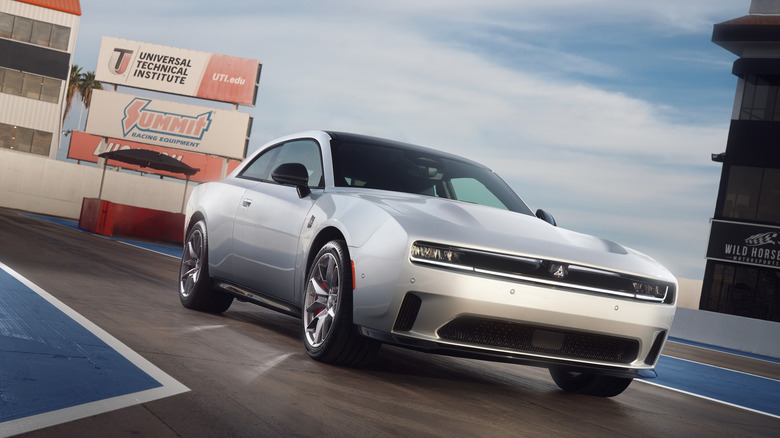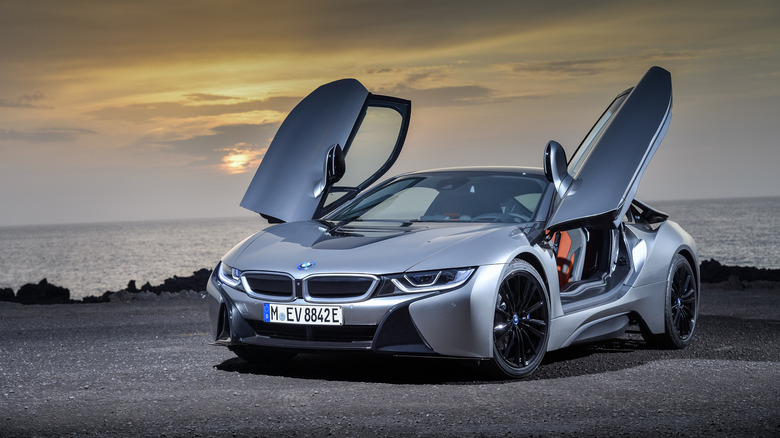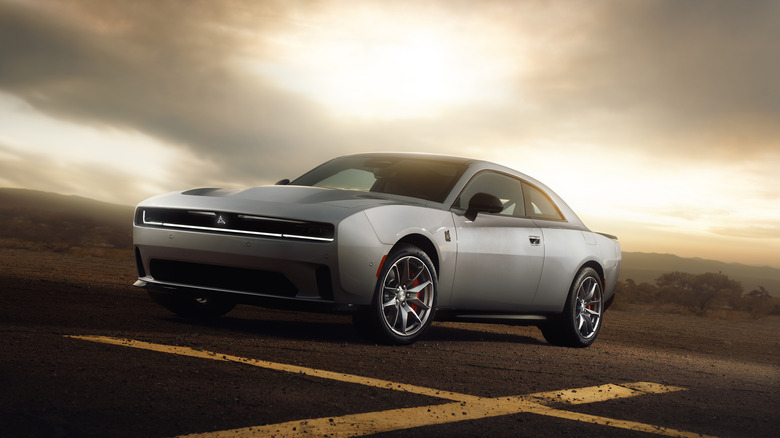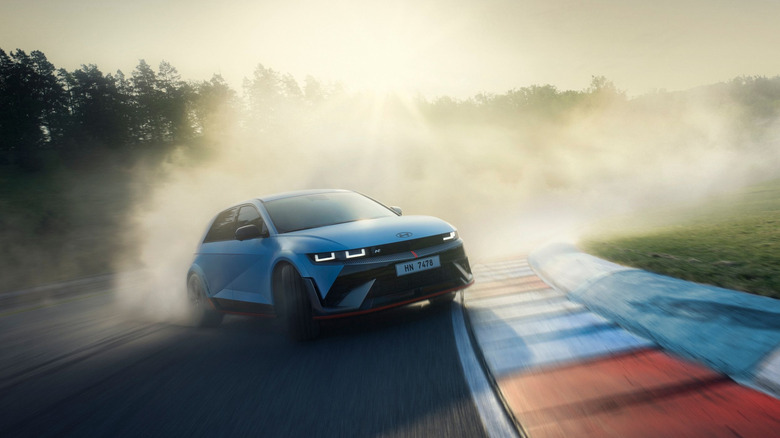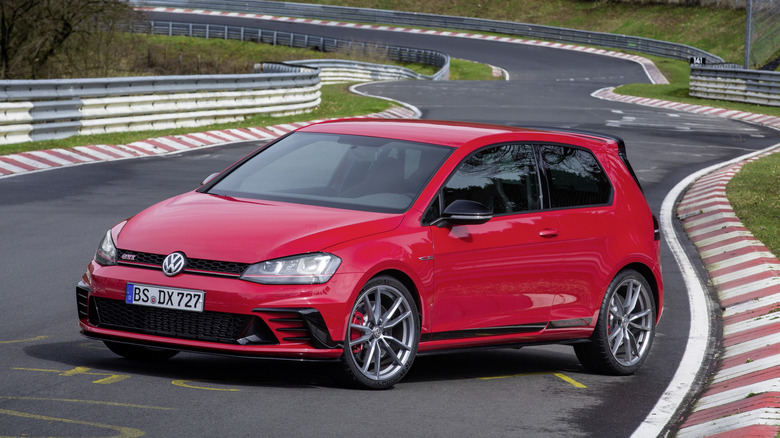5 Cars That Use Fake Engine Sounds
Whether it's legal concerns or making enthusiasts feel more at home, fake engine noises serve multiple purposes and are prominently featured on a wide array of makes and models. Typically on EVs and high-performance cars with otherwise underwhelming audio signatures, the general logic behind these noises is often one of either immersion, safety, or both. These artificially created or enhanced noises may be one of the most divisive automotive trends in recent years, with some stating that it's essentially tricking owners and passengers into thinking the car is something that it's not.
However, fake engine sounds do serve a specific purpose on some cars, namely in alerting pedestrians to the car's state of motion. Take an all-electric car, for instance; such a vehicle produces no engine noise when at rest, obviously. Moreover, it can move instantly with no warning since electric motors produce maximum torque from a standstill.
The fake noises themselves come from a variety of sources. Common sense dictates, of course, that an EV cannot produce combustion engine noises; in those cases, the sounds are just artificially generated or pre-recorded, like a video game. In other cars, like several performance BMWs, for example, the sound instead comes from inputs within the engine itself, like plugging a guitar into an amplifier. The sound usually plays through the car's speakers, leading some to manually deactivate it, whereas EVs sometimes play sound via external speakers mounted where the exhaust would be. Polarizing and irritating to some as they may be, a huge variety of models still utilize this technology. Some sound powerful, others subdued, and some just plain sound weird. Let's explore some examples, how the different systems all work, and what practical benefits and detriments each have.
Active Sound Design: BMW i8
This wild-looking exotic represents one of the most distinctive BMWs of the 21st century, featuring butterfly doors, all the usual appointments befitting a German luxury car, and a 369-horsepower combined output, all wrapped up in a compact, sporty package. While no longer in production today, the BMW i8 utilizes all the contemporary technology one would expect of such a vehicle, including a hybrid-electric powertrain with a relatively small 1.5L turbocharged three-cylinder engine that, on its own, still produces a respectable noise. However, like many BMWs, the i8 isn't exactly loud on the inside and, likely in an effort to appeal to the sportier target demographic, features a little extra "push" by the company's Active Sound Design system.
This system is found in a wide variety of BMW models, typically M-spec cars such as the M5, M240i, the X-series M crossovers and SUVs, and so on. As such, it's inferred that this helps bring out the car's sportier image without sacrificing on the luxury; for instance, in a BMW so-equipped, you'll find various settings for the Active Sound Design. These include modes for sportier or more laid-back experiences, allowing the user to essentially tailor which experience they want, in theory. Likewise, this sound is projected outside the car to offset the ever-quieter exhaust note, and the i8 is no exception here. In fact, it features a dedicated speaker just for this very purpose: to enhance the car's outside audio and make it sound sportier than a small inline-three. Moreover, it features pedestrian warning speakers in EV mode to let pedestrians know the car is there, something we'll see a lot of with other cars on this list.
Fratzonic Chambered Exhaust: Dodge Charger Daytona EV
Unlike the i8, this Charger Daytona features no internal combustion engine. The Charger has certainly garnered its share of criticism as of late, with the engine (or lack thereof) cited among its list of complaints. But what about the noise? That's actually played through a massive speaker located on the underside, effectively one of those entertainment system speakers underneath TVs, and approximately imitates the dulcet tones of a HEMI V8.
Called the Fratzonic Chambered Exhaust, the sound itself is quite loud, appropriately so for a muscle car boasting 670 horsepower and under three second 0-60 times. But this system was also subjected to criticism following a recall whereby the exterior amplifier was missing critical components, meaning the car wasn't actually producing the correct sound. This was further compounded by the fact that the federally mandated exterior pedestrian safety speaker, as mentioned on the i8, was also affected.
Whether the engine noise is to your taste is subjective, and aside from the build quality, the fact remains that this is still an exceptionally fast vehicle, being touted by Dodge as the world's quickest muscle car. Additionally, the 2025 Dodge Charger Sixpack features a 3.0L turbocharged "Hurricane" straight six producing 550 horsepower, marking the return of the internal combustion engine to the lineup. While we don't know if it'll actually receive a HEMI instead of just pretending like it has one, such a decision would make economic sense for Dodge, so we can only hope. In the meantime, owners must remain content with either the six or the EV package, though neither of these options are slouches by any means.
N Active Sound+: Hyundai Ioniq 5 N
The Hyundai Ioniq 5 N mirrors the Charger Daytona in that both vehicles feature electric powertrains coupled with artificially-produced combustion engine noise. The audio program, called N Active Sound+, simulates a combustion engine and rev counter similar to any ordinary gas-powered performance hot hatch, revving up to a nonexistent redline when the driver mashes the skinny pedal. Much like the BMW, this sound is also adjustable, meaning you can program the car to produce different engine notes based on a pre-set selection.
While not quite as powerful as the Charger Daytona, the Hyundai Ioniq 5 N comfortably sits in the same class, boasting up to 641 horsepower. Considering this is an enthusiast car marketed to an enthusiast audience, it makes sense that the trademark audio signature of a sports car is preserved here; whether it's your thing is, of course, a matter of opinion. But it has all the bells and whistles to go with it, even featuring a virtual sequential manual gearbox that's simulated with paddles that "change gears" by simulating the revs going up or down. This is likewise coupled with a change in power delivery that one would expect when shifting gears as well, and even simulating the sounds associated with engine braking.
It's not to everyone's taste, but the amount of detail that went into recreating a driver-centric experience is commendable in this otherwise mute vehicle. Of course, it's still no substitute for the real thing, but it's certainly a clever bit of engineering and shows a level of passion beyond what some manufacturers offer in similar cars, one of several reasons why we think it's an exciting EV to own.
Soundaktor: Volkswagen Golf R / GTI
Dating back to 2011, Volkswagen's "Soundaktor" audio is an earlier example of electronic sound manipulation, as opposed to traditional mechanical audio signature modification like with aftermarket exhaust and such. Instead of playing the audio through the car's loudspeakers, however, Volkswagen Auto Group's (VAG) solution was to fit the speaker to the firewall.
Previously, VAG equipped its cars with resonator tubes that enhanced the audio coming through the frame; after all, sound is just waves displacing air. If something vibrates, it produces a specific note, so theoretically, using a car's frame or its firewall produces an effect by effectively turning the car into a giant tuning fork. As such, this device acts like a resonator, projecting sound using the firewall as an ad-hoc amplifier. Much like all the other systems, this one can be disabled as well, either by removing the fuse for it or just taking the whole system out; it's merely a speaker and housing bolted on to the firewall inside the engine bay.
While perhaps most infamously placed inside performance variants of the Volkswagen Golf since its introduction in 2011, the Soundaktor also enhances audio in a variety of other vehicles. These include some Audi TTs, Beetle Turbo, Audi A3 and A5 (and their respective "S" variants), Škoda Octavia, and more; the juggernaut owns many brands, after all. This means that, generally speaking, many new cars manufactured by Volkswagen Auto Group in general utilize some sort of Soundaktor system to enhance audio within the car. However, because it's connected to the vehicle's frame, this sound doesn't resonate beyond the immediate range, meaning unlike the Charger Daytona, these vehicles don't emit additional simulated external audio via the Soundaktor system.
Engine Sound Enhancement: Toyota GR86 / Subaru BRZ
Toyota's GR86, a peppy sports coupe, as well as V8-equipped Toyota pickups, namely the Tundra and Tacoma, and others like the Avalon, come equipped with an audio suite called the Engine Sound Enhancement. Unlike prior systems, however, this unit actually uses multiple microphones to pick up audio, namely the Intake Air Sound Creator and Active Noise Control, respectively. The former is responsible for tuning and amplifying the sound coming from the engine itself via the intake, as its name suggests. Meanwhile, the latter enhances the audio by tuning out unwanted noise in the vehicle. Basically, this system functions similarly to dynamic noise-canceling headgear, where two elements are present: one to cancel out loud noises and the other to enhance specific quieter ones.
While it's featured on a number of Toyota models, the most prevalent of these, and perhaps the most obvious, are the V8s and the GR86. This car features a rather modest powertrain, boasting just 228 horsepower from the Subaru Boxer engine, one of several non-Toyota engines fitted to various Toyota vehicles. The GR86 wasn't designed to be fast, but rather exceptionally fun and responsive, which is likely why Toyota fitted such a device to the car — it adds an extra level of sensory engagement with an otherwise diminutive stock sound. Similarly, the sound adorns larger V8-equipped trucks because a deep, low growl is something one would expect from a V8.
Naturally there are methods to disable this system, as many DIYers often do. Of course, being a shared platform, the Subaru BRZ, the GR86's sister car, also utilizes this device to produce fake engine noise. As such, disabling that system, if one desires, is performed via the same methods.
